Table of Contents
Introduction to Refreshing Dessert Recipe
The Exotic Fruit Tartare with Matcha Tea and Basil Granita is a vibrant dessert that showcases the natural sweetness and tartness of tropical fruits, paired with the earthy bitterness of matcha and the refreshing aroma of basil.
The fruits are diced, marinated in vinegar, and presented with mango sorbet or inside a rhubarb ring. Matcha tea and basil granita add a complex flavor balance, blending sweetness, tartness, and bitterness. The dish emphasizes harmony in taste, using ingredients like passion fruit, rhubarb, and matcha for an exotic twist. Each element contributes to a visually appealing and flavorful experience that is perfect.
Background Information
Exotic fruit tartare is a vibrant and refreshing dessert that emphasizes the natural flavors and textures of various tropical fruits. To prepare this dish, peel and dice the fruits into 5 mm cubes, then marinate them in Apple Cider Vinegar, sprinkle with lime juice, and add sugar.
The tartare can be presented by forming the fruit into a 15 cm diameter circle, topped with a scoop of mango sorbet, and garnished with mint leaves. Alternatively, the fruits can be arranged inside a rhubarb ring, created by slicing rhubarb stalks into thin strands, lightly sugaring them, and drying them in a preheated oven for about six hours.
The mango sorbet is made by boiling a mixture of orange juice, water, granulated sugar, and glucose to create a syrup, which is then combined with mango puree and lime juice before being frozen.
Although some might consider tropical fruits like passion fruit to be exotic and challenging to use, they are, in fact, quite accessible and versatile in dessert recipes. Passion fruit, in particular, is celebrated for its sweet-tart flavor and vibrant marigold-colored pulp, which adds a delightful tropical twist to various dishes, including tarts and curds.
This dessert, which also incorporates matcha tea and basil granita, combines the tartness and sweetness of tropical fruits with the unique flavors of matcha and basil. It is a complex and refreshing dessert perfect for summer dining.
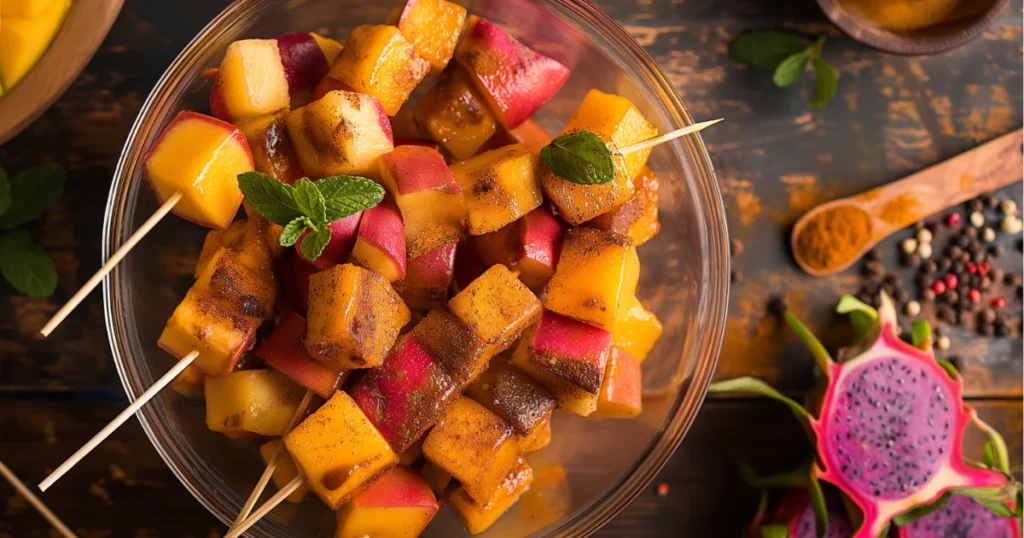
Flavor Balance
Achieving the perfect flavor balance in an exotic fruit tartare with matcha tea and basil granita involves a nuanced understanding of the five basic tastes: sweet, salty, sour, bitter, and umami.
The interplay of these elements is essential to elevate the dish from simply good to extraordinary.
When combining the tartness of rhubarb with the sweetness of exotic fruits and the unique taste of matcha tea, it is critical to introduce contrasting flavors without overwhelming the original components of the dessert.
A dash of acidic ingredients, such as citrus or vinegar, can counteract excessive sweetness but a reasonable amount of salt can enhance and balance the overall flavor profile.
The art of flavor balancing is both scientific and creative, requiring tasting as you go and adjusting accordingly. Understanding how each flavor element interacts with the others helps in creating a balanced taste.
For instance, adding a touch of bitterness from the matcha tea can offset the sweetness of the fruits, creating a more rounded taste experience.
Incorporating these techniques and paying close attention to the balance of flavors ensures that each bite of the exotic fruit tartare with matcha tea and basil granita provides a memorable culinary experience.
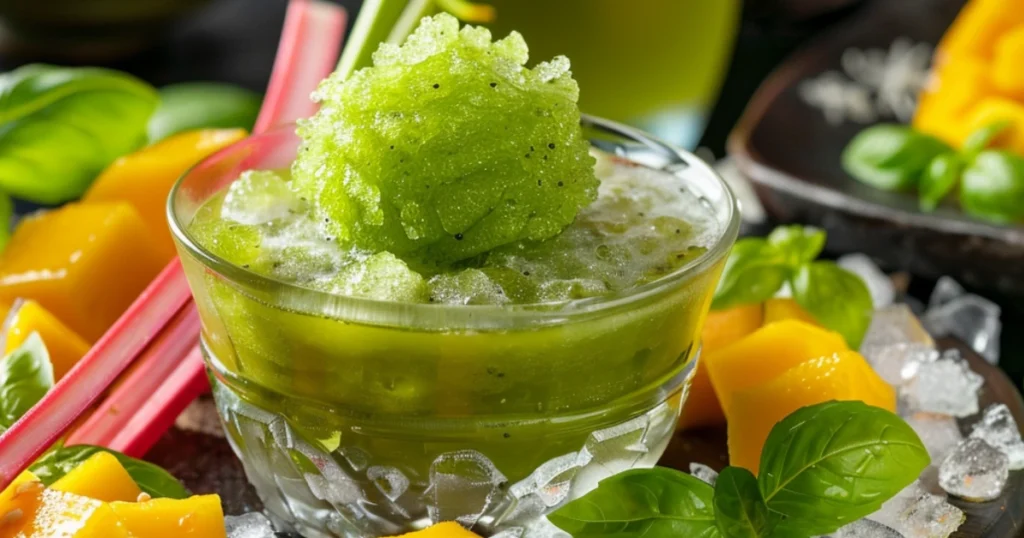
Matcha Tea and Basil Granita
Matcha tea is an integral component of this exceptional dessert combination. It is known for its high concentration of antioxidants, caffeine, and amino acids.
Originating from Japan, matcha is a powdered form of green tea that involves consuming the entire tea leaf, thereby offering more potent nutrients compared to regular green tea.
The production process for matcha involves shading the tea plants during growth to enhance chlorophyll and amino acid content, which gives the leaves a vibrant green hue and a distinctive taste profile.
Matcha is categorized into various grades, mainly ceremonial and culinary. Ceremonial grade matcha is revered for its superior quality and is typically used in traditional tea ceremonies, while culinary grade matcha is used in cooking and baking due to its stronger flavor. For this dessert, choosing the right grade of matcha is crucial to ensure a harmonious balance with the basil granita.
The vibrant green color and unique flavor profile of high-quality matcha make it an ideal pairing with the fresh and aromatic basil granita. The slightly bitter and rich taste of matcha complements the refreshing and sweet notes of the granita, creating a well-rounded and exotic flavor experience.
Additionally, matcha’s high antioxidant content provides a healthful benefit, enhancing the overall appeal of this gourmet dessert.
Selection of Exotic Fruits
Choosing the right combination of exotic fruits for a tartare ensures a balanced medley of flavors and textures, resulting in a refreshing and visually appealing dish. There are over 20,000 species of edible fruits worldwide, each offering unique taste profiles and health benefits. When selecting fruits for an Exotic Fruit Tartare with Mango Sorbet, it is essential to consider the harmony of flavors and textures.
Fruits should be peeled and diced into 5 mm cubes to ensure uniformity. They can be marinated in Apple Cider Vinegar, sprinkled with lime juice, and sweetened with sugar to enhance their natural flavors.
For instance, passion fruit, known for its tart and citrusy flavor, adds a vibrant punch and can balance out the sweetness of other fruits in the tartare.
Experimenting with different fruits allows for creativity and customization based on personal preferences or seasonal availability. Whether you opt for the gelatinous texture of passion fruit or the refreshing taste of dragon fruit, the key is to research and understand the origins, nutritional value, and best preparation methods for each fruit to maximize their culinary potential.
Rhubarb Ring
The rhubarb ring is an intriguing element that adds both visual appeal and a unique texture to the exotic fruit tartare with matcha tea and basil granita. Rhubarb, often mistaken for a fruit but technically a vegetable, lends its tart and vibrant flavor to this dish, providing a refreshing contrast to the sweetness of other components.
To create a rhubarb ring, you start by selecting the freshest rhubarb stalks available, ensuring they are firm and vibrant in color. Begin by trimming the ends and removing any stringy outer layers, similar to how you would prepare celery. Cut the rhubarb into even lengths, and then use a mandoline or a sharp knife to slice the stalks lengthwise into thin, flexible ribbons.
These ribbons are then gently poached in a simple syrup until they become tender but still hold their shape. This process not only softens the rhubarb but also infuses it with sweetness, balancing its natural tartness. Once poached, the ribbons are carefully wrapped around a circular mold or form to create the ring shape. Allow the rhubarb to cool and set, which helps it maintain the ring structure upon removal from the mold.
When incorporated into the exotic fruit tartare, the rhubarb ring adds a sophisticated touch. Its slightly chewy texture complements the crunchiness of the other fruits, while its tart flavor enhances the overall taste profile of the dish. The rhubarb ring’s vibrant color also provides a visually appealing contrast, making the tartare not only delicious but also a feast for the eyes.
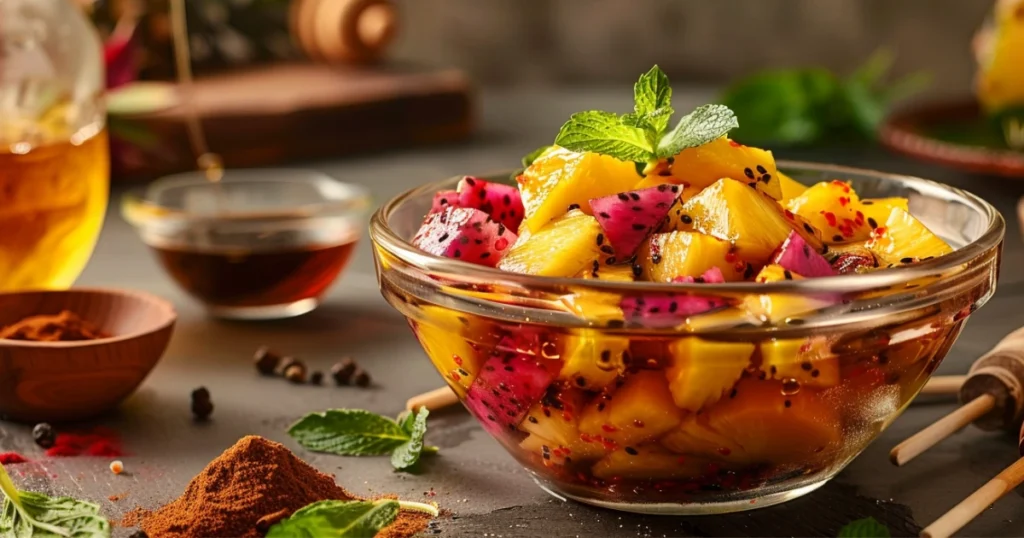
Marinating Exotic Fruits
Marinating exotic fruits can significantly enhance their natural flavors and contribute to the overall taste profile of the dish.
This technique involves soaking the fruits in a mixture of ingredients that complement their unique tastes, thereby amplifying their sweetness and adding depth to their flavor.
For example, marinating pineapple in a blend of brown sugar and cinnamon before grilling can create a rich, caramelized exterior that enhances its natural sweetness.
Firm fruits are generally the best candidates for marination, as they hold up well under heat and maintain their texture. The marination process not only infuses the fruits with additional flavors but also helps in achieving that perfect combination of sweet and smoky tastes when grilled.
Different fruits require different marination times and ingredients. For instance, mangoes and pineapples might benefit from a shorter marination period with a sweeter marinade, whereas firmer fruits like dragon fruit might require a longer soak in a more robust mixture.
Using a variety of wood chips and glazes can further elevate the flavors, providing a unique twist to each fruit.
This is especially beneficial when preparing dishes like exotic fruit tartare, where the complexity of flavors can shine through. By carefully selecting the marinade components and timing, you can create a harmonious balance that enhances the natural taste of the fruits while introducing new flavor dimensions.
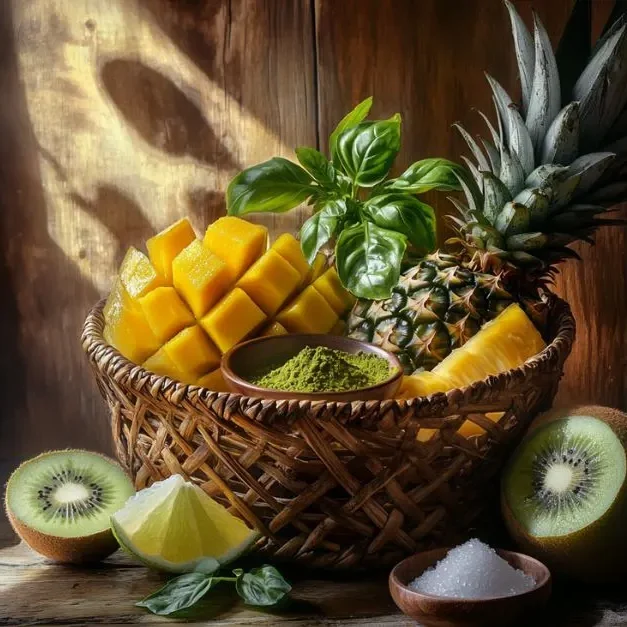
Preparation of Matcha Tea and Basil Granita
To achieve the perfect texture and flavor balance for matcha tea and basil granita, it is essential to start with high-quality matcha powder, known for its vibrant green color and refreshing flavor.
Matcha, a finely ground powder made from green tea leaves, lends a distinct bitter and grassy note that pairs well with various dessert ingredients.
Begin by preparing the matcha tea. Dissolve the matcha powder in hot water, ensuring it is thoroughly whisked to avoid any clumps, which is critical for achieving a smooth consistency. The amount of matcha can be adjusted based on the desired intensity of flavor.
For the basil granita, fresh basil leaves should be steeped in a simple syrup made from water and sugar. Once the basil has imparted its flavor into the syrup, remove the leaves and allow the mixture to cool. Combine the prepared matcha tea with the basil-infused syrup and pour the mixture into a shallow container.
Freeze the mixture, and every 30 minutes, scrape it with a fork to break up any ice crystals, ensuring the granita develops a fine, flaky texture. This process is repeated until the entire mixture is frozen, resulting in a refreshing and aromatic granita.
Conclusion
Try this Tropical Fruit Dessert today and share your creative variations in the comments!

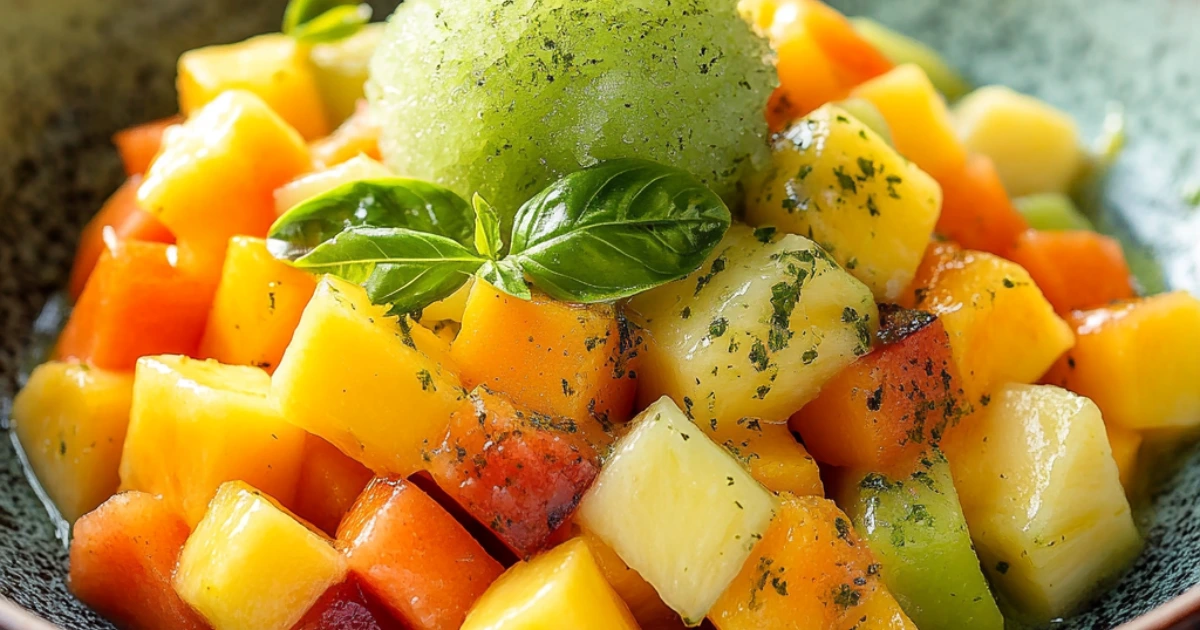
1 thought on “Delicious Exotic Fruit Tartare with Matcha & Basil Granita – Ready in 30 Min!”
Comments are closed.